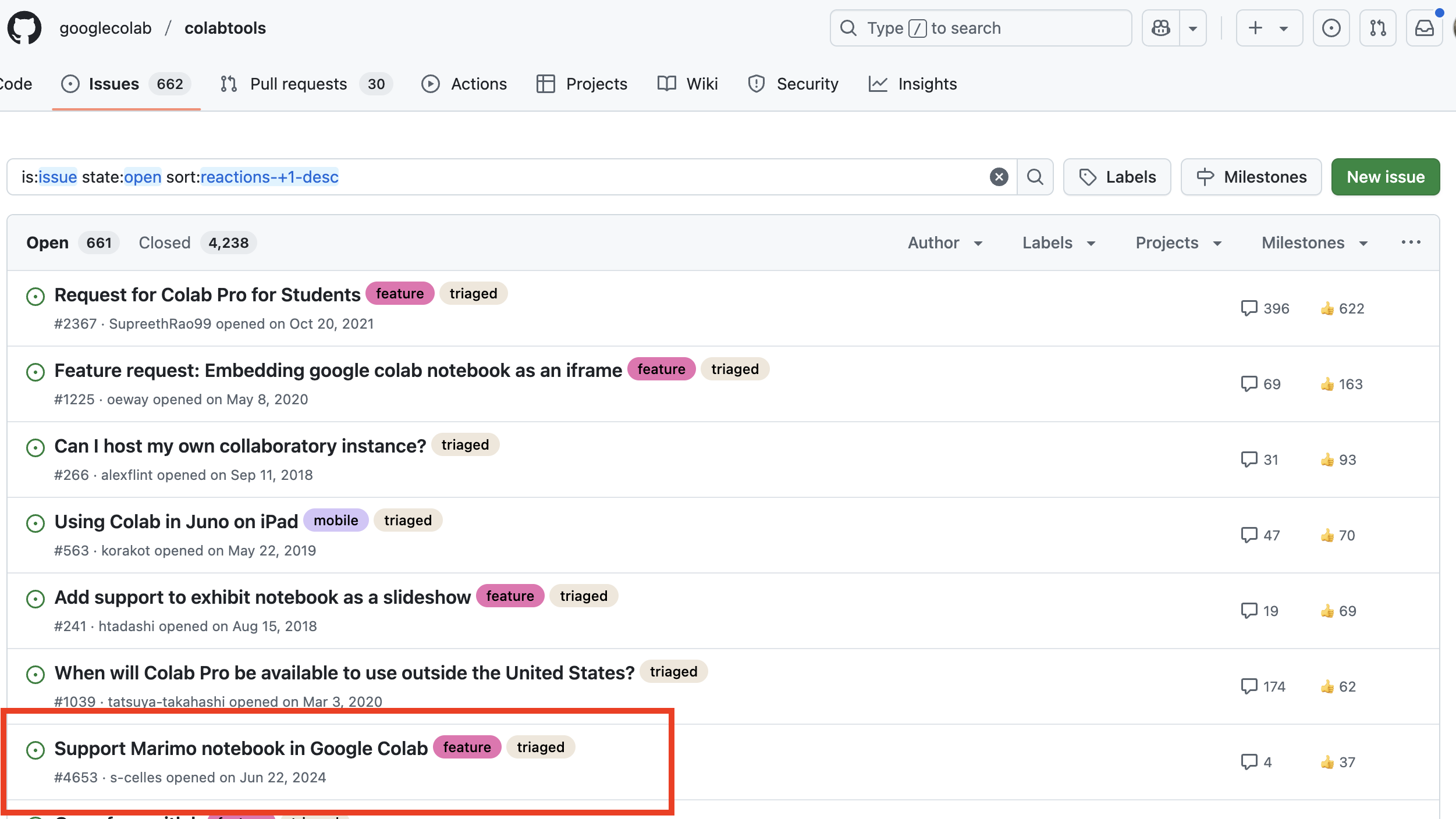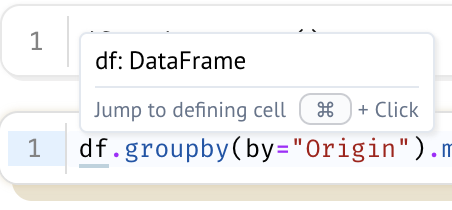
This is your monthly reminder that at marimo, we’re on a mission to make the
world’s best programming environment for working with data, and it’s all free
and open source. Just pip install marimo or uv add marimo to get started!
You’re reading the 16th marimo newsletter. Our newsletters are usually packed, but this one is especially substantial, with several big announcements.
Feedback? If you have feedback, we want to hear from you! Hit reply or fill out our survey.
Announcing molab 🍃
Today, we’re excited to announce molab, a cloud-hosted marimo notebook workspace with link-based sharing, letting you experiment on data using the world’s best Python notebook. We’re giving molab (mo for marimo) to you, our community, for free.
To create your first notebook, just visit https://molab.marimo.io; to get inspired, check out example notebooks on visualizing embeddings, calling LLM inference providers with HuggingFace by Vaibhav Srivastav from Hugging Face, annotating data with W&B Weave by Scott Condron from W&B, and more. and more. We’re excited to see the notebooks you all make (please send them to us and we’ll be happy to highlight them!). If you have feedback, please let us know: molab is under very active development.
Highlights.
- ☁️ Use any Python package, thanks to our cloud backend
- 📦 Upload data files
- 🔗 Share links (notebooks are public but undiscoverable, like secret GitHub Gists)
- 🤖 Generate code with AI
- 📥 Download notebooks to your machine, reuse them as Python scripts or apps
- 📤 Upload local notebooks to the cloud from our CLI (coming soon)
- Real-time collaboration (coming soon)
- Configure computational resources to obtain more CPU or GPU (coming soon)
Why we’re building molab.
While you can use marimo locally (just pip install marimo), many of you have
told us how valuable a marimo-powered Colab-like service would be for running
machine learning and AI workloads. In fact, the most popular recent feature
request in Google Colab’s issue tracker asks for marimo support in
Colab:

Rather than try to convince Google to replace their notebook with marimo, we decided to just build molab instead.
Learn more. To learn more (including a behind-the-scenes look at our modern tech stack), make sure to check out our announcement blog.
P.S. molab is for our community; it is not our commercial product. Stay tuned.
Cloudflare bets on marimo
Earlier this week, Cloudflare announced they’re betting on marimo as the interface to Cloudflare data. Thanks to a lightweight integration co-developed by marimo team and Cloudflare engineers, it is now easy easy for Cloudflare customers to explore data on R2 object storage with marimo notebooks in a secure and authenticated way.
At the same time, Cloudflare launched https://notebooks.cloudflare.com which (you guessed it) has a collection of sample marimo notebooks that help people explore their Cloudflare data.
Here’s what Cloudflare has to say about marimo:
Traditional notebooks are incredibly powerful — but they were not built with collaboration, reproducibility, or deployment as data apps in mind. As usage grows across teams and workflows, these limitations face the reality of work at scale.
marimo reimagines the notebook experience with these challenges in mind. It’s an open-source reactive Python notebook that’s built to be reproducible, easy to track in Git, executable as a standalone script, and deployable. We have partnered with the marimo team to bring this streamlined, production-friendly experience to Cloudflare developers. Spend less time wrestling with tools and more time exploring your data.
Learn more at their blog.
New features
Since our last newsletter, we’ve shipped 11 new releases with many new features. Thanks to marimo team member Trevor Manz, our release notes are more detailed and comprehensive. Here are some highlights:
Command mode. Many of you have told us that command mode (and its keyboard shortcuts) was the one feature you missed most from Jupyter. We heard you, and we’ve built it into marimo.
Command mode lets you work at the cell level — navigating between cells,
creating new ones, and applying operations to multiple cells at once. Press
Escape to enter command mode (the cell border turns blue), and press Enter to
return to edit mode. From command mode you can easily create new cells,
copy and paste cells, select multiple cells to move, run, or delete them, and more.
When vim keybindings are enabled, command-mode even supports familiar keybindings
such as j/k for navigation.
hk
A revamped data editor. The data editor plugins (mo.ui.data_editor and
mo.ui.dataframe) have been totally upgraded: you can now paste from
clipboard (copy from Excel!), add/rename/delete columns, delete rows, and more.
These improvements make the data editor feel more like a spreadsheet when you
need it, while maintaining dataframe operations.
Dataframe selections. You can now select dataframe/table cells with your cursor or keyboard, copy your selection to clipboard, and click nested entries to get a rich view.
Variable reference highlighting with go-to-definition. The marimo editor
can now highlight cell references, i.e. variables that they use but don’t
define. This helps you understand how data flows through your notebook at a
glance. You can even hover over the variable and Ctrl+Click to jump to
definition.

This feature is currently opt-in: enable in the settings (Display > Reference Highlighting), or through the command palette (Ctrl/Cmd + k)
Improved package panel when using uv. View your packages as a tree instead of
a flat list when using the uv package manager. See our release notes for example videos.
📬 In case you missed it …
📺 Learn how to use Claude code to write marimo notebooks. Because marimo is stored as Python files, it just works!
🤖 Hamel Hussain and Vincent Warmerdam jam on building eval tools for AI, featuring (of course) marimo notebooks
📝 Use marimo’s quarto plugin to make interactive documents.
📚 Our marimo learn Polars series is nearing completion thanks to Debajyoti Das, @etrotta, Jesse Hartman and others. The DuckDB course is gaining momentum with Thomas Liang’s contributions. Want to help? Check out existing issues or propose new topics. marimo learn is spearheaded by Srihari Thyagarajan.
🍃 Community
We crossed 14.5k stars on GitHub, have 150 contributors pushing code to marimo, over 300k YouTube views, over 300k monthly downloads, and 2.5k marimonauts hanging out on Discord — join the conversation!
Roundup. So many of you are writing about marimo and making awesome notebooks; here’s just a small slice of what our community has been up to.
📖 Production-ready data science, by Khuyen Tran. Learn how to go from messy notebooks to production in Khuyen’s new book; part of the solution is to marimo, which makes your notebooks reproducible and production-ready by default.
dlt bets on marimo. The open-source ETL library dlt replaced streamlit with marimo as the tool of choice for exploring data and creating data artifacts.
📺 Real Python launches a marimo course. RealPython is known to make the best tutorials for the Python ecosystem, and they just made a marimo course. Don’t miss it!
📖 Ecosystem documentation. Thanks @Coderambling for updating HoloViews’ Panel documentation to include marimo.
🎤 Meet marimo: The Next-Gen Notebook by Sven Arends at EuroPython. Sven introduces marimo with live demos and interactive examples, now available on molab and GitHub.
📊 Great Tables + marimo = Interactive Tables by Rich Iannone and Jerry Wu. Embed marimo widgets directly into Great Tables for real-time interactivity, with live demos powered by our playground here and table construction by Yi-Cheng Wu.
️ nutpie progress bars The fast Rust-based NUTS sampler now displays beautiful progress bars in marimo notebooks, making Bayesian sampling workflows more user-friendly.
Understanding LLM Memory by Alonso Silva Allende. Explore how language models handle memory using transformers_js_py in an interactive marimo notebook that runs entirely in the browser.
A Simple Atlas of Projections by David O’Sullivan. Explore map projections interactively with marimo-powered visualizations that make cartographic concepts accessible and engaging.
Don’t forget to submit your projects to our awesome-marimo repo!
Sincerely,
marimo team 🍃
